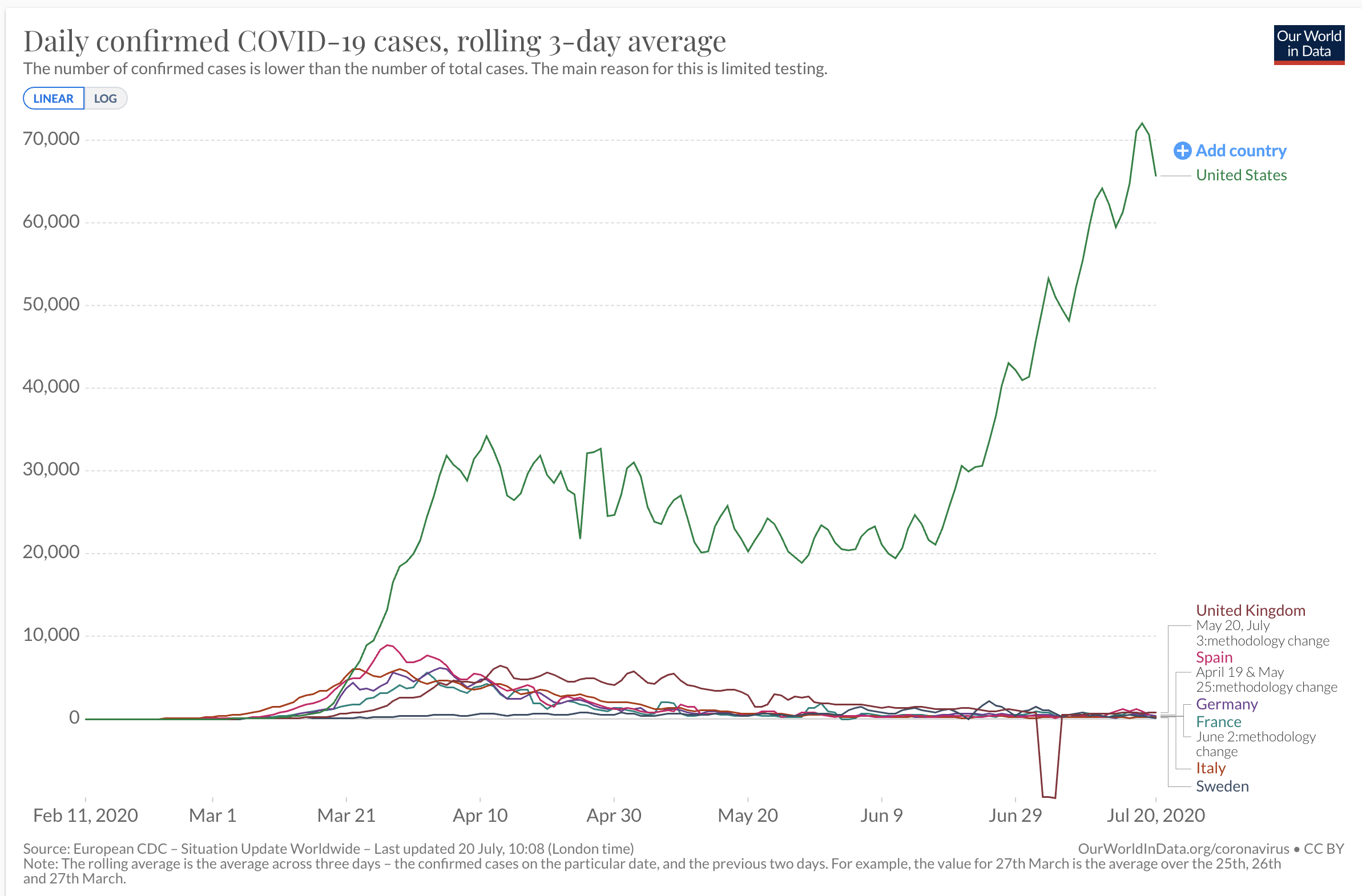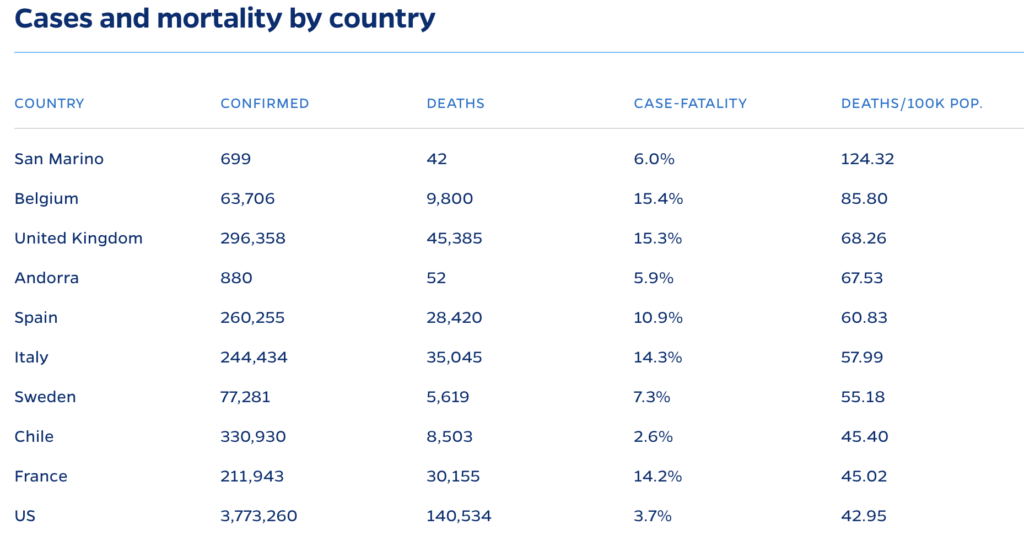America Dances (part 4): US vs EU pandemic response

In my previous America Dances posts earlier this month (July 2020 part 1, 2, 3), I summarized where we are now in this pandemic; highlighted the unfavorable comparison we’re making with the European Union’s experience at this point; and summarized the factors that have driven the decisions leading us here. Amid all this bad news I ended with the question: Is there an advantage to the American approach?
Let’s consider two categories: economic and medical.
US vs the EU: Which approach is better for the economy?
Back in March, a powerful argument against lockdowns was that the economic harm was disproportionate to the health threat. It was said lockdowns would cripple livelihoods, small businesses, industries, and overall economic activity at a financial cost not justified by the number of lives that would be saved. This was a fair argument, though complicated by an inability to accurately predict how many lives were at risk because the virus was so new. Were a thousand lives at risk? A hundred thousand? Millions?
Many Americans resisted lockdowns on a less-rational basis. They claimed to already know that SARS-CoV-2 was no more deadly than seasonal influenza and therefore not worth fighting against, or that the virus was even a hoax. Rather than say they thought a half-million preventable deaths would be an acceptable cost for doing nothing, the “flu” camp denied that the virus would extract any significant toll at all.
We have since learned that SARS-CoV-2 is significantly more lethal than seasonal influenza, though probably not as deadly as the 1918 pandemic flu and far less lethal than the original SARS, Ebola or smallpox. We have also learned that you can’t have your cake and eat it too. If people engage in economic activity that requires in-person association, you don’t save the economy because then the pandemic gets out of control—and a pandemic naturally squelches part of the economy, whether governors issue stay-at-home orders or not. When meatpacking plants have to close because too many workers are sick with COVID-19; when the majority of people will not attend a theater or indoor sporting event because the virus is circulating in their community; and when the risk of opening schools is high, we suffer an economic (and social) cost that is separate from any government regulation.
In other words, reopening in itself does not give you a “V”-shaped economic recovery. You have to get the virus under control too.
And here’s where the EU has probably done better economically, at least for now. (I’m ignoring the massive role of federal spending to support the US economy despite the virus.) Reopening with the pandemic under control allows more normal economic activity—more businesses open, schools open, etc. Governments can loosen restrictions and the people can feel okay about it. With greater health security, consumers can go out and spend, working parents can send their children to school, and workers can return to jobs. As long as the number of new cases is small or moderate, contact tracing with quarantine can keep the virus in check while reopening. That’s what is happening in most of the EU. You don’t have a fully open economy, but you have something more comfortable and sustainable.
In the US, in some places there are too many new cases to track and isolate contacts, so the virus keeps growing. Too many new cases makes bars and social venues too risky to open. High prevalence of the virus in the community makes in-person school attendance a higher risk than it is in the EU.
As long as a significant proportion of us feel the pandemic is a threat, the economy will not come back. Even if you do not feel threatened by the virus—even if you think everyone else is overreacting, or that the deaths are acceptable—you should accept that recovery requires more than just ending government-imposed restrictions. People are being cautious. Beat the pandemic, and the economy will revive.
America vs the EU: which approach saves more lives?
The answer is complicated. First, there is significant regional variation within the EU, just as there is within the US. If we compare COVID-19 deaths per 100,000 people in the country’s population, the US as a whole is doing much better than a few European countries, and much worse than others. {See table, Source: https://coronavirus.jhu.edu/data/mortality}

The UK has lost 68 people per 100,000 to the virus; Spain and Italy, around 60; and Sweden, 55. The US number is about 43. On the other hand, the small island nation Iceland is at about 3; and Germany, which is turning into a model for how this pandemic should have been managed in a large country, has suffered only 11 coronavirus deaths per 100,000 people.
But these numbers are only true up to the present time. What about the next three to six months? The virus is under better control in the EU. The continent has more people than the US but is adding new coronavirus cases at a fraction of what we are: around 4,000 new cases a day, versus closer to 70,000 in the US right now. {See figure at top of post.} Will this eventually translate into more American over European deaths? Yes. How many deaths depends on several things. Who is getting infected? Most new infections in the US are in young people who are unlikely to add to the death count. But more cases in young people raises the risk of infection for everyone. Will hospitals be overwhelmed? Treatment for COVID-19 has improved but an overflow surge of cases will increase the death rate. Can we protect our elder care facilities? This is where the mortality skyrockets. And how long will this high infection rate continue? If Americans embrace non-pharmaceutical interventions, we might turn this around. In a pandemic, both victories and defeats are reversible.
Mortality isn’t the only health measure that matters. COVID-19 makes people sick, sometimes for weeks or longer. Some people experience long-term health consequences other than “death.” This will happen to fewer Europeans than Americans in the weeks ahead.
Social Values
America’s response to the pandemic reflects larger social values that are currently ascendant in our national government. What are these values? First, a preference for freedom over safety. Our pandemic response parallels our national support for gun ownership. Exercising the right to bear arms is valued more highly than the lives of Americans who die of gunshot wounds (about 40,000 in 2017.) Second, a preference for individual bearing of risk/reward over collective sharing of risk/reward. Some argue that each American should be able to do as they please, to manage their own risk tolerance during the pandemic, and face the consequences as an individual—as opposed to following a collective strategy that asks low-risk individuals to sacrifice personal choice for the benefit of the group as a whole. We see this with the pandemic, and also in our national tolerance for inequality.
Broadly, these values are not the dominant values in Europe today so perhaps it’s not surprising that we are here.
Herd Immunity: Is this a win for the US?
The US is accumulating around 70,000 new diagnosed cases a day. This is bad, and Europe shows us it is also unnecessary. Nevertheless here we are. Is there a silver lining to this cloud? The overwhelming majority of these cases, as well as hundreds of thousands of people who are infected but not tested for SARS-CoV-2, will soon recover from the virus. Are we building herd immunity? That’s a very good question. Stay tuned.
Amy Rogers, MD, PhD, is a Harvard-educated scientist, novelist, journalist, and educator. Learn more about Amy’s science thriller novels, or download a free ebook on the scientific backstory of SARS-CoV-2 and emerging infections, at AmyRogers.com.
Sign up for my email list
Share this:



0 Comments